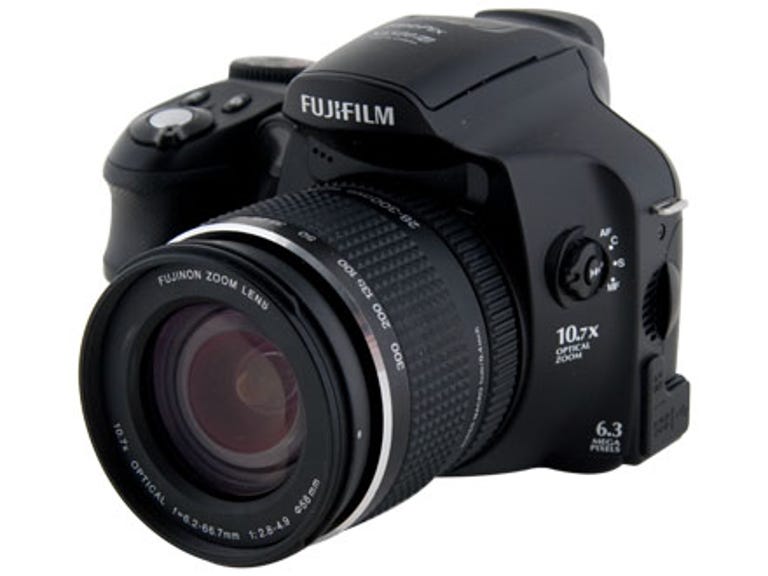 Why You Can Trust CNET
Why You Can Trust CNET Fujifilm FinePix S6500fd review: Fujifilm FinePix S6500fd
The 6-megapixel Fujifilm FinePix S6500fd isn't the longest superzoom by any means -- its 10x zoom only just qualifies it for the category. But size isn't everything, and with some excellent dSLR-like features, the S6500 is an attractive package -- especially at its current price
The 6-megapixel Fujifilm FinePix S6500fd isn't the longest superzoom by any means. In fact, its 10x zoom only just qualifies it for the category. But size isn't everything, and with some excellent dSLR-like features, the S6500 is an attractive package -- especially now the the price has crept below £180 in some stores online. The question is whether this, the first camera to include face detection, has been left behind by newer models.
The Good
The Bad
The Bottom Line
Design
The S6500fd's handgrip is chunky and easy to hold, even with one hand. The camera is lightweight at 700g, but with the sturdiness of an dSLR. Too many superzooms have above-average zoom performance hobbled by terrible zoom controls, but here zoom is controlled with the lens ring, for that dSLR experience.
The control layout is surprisingly sparse. The clickpad has a menu button in the middle, while shooting modes get their own button. Another button toggles between the 64mm (2.5-inch) live view screen and the electronic viewfinder. As with most EVFs, it's not much fun to use. The image is jerky and not fine enough for checking focus, with a meagre 115,000-pixel resolution. Still, it's acceptable for composition.
The mode dial gives access to Program, Shutter Priority, Aperture Priority and Manual modes, as well as video and scene modes.
Features
The S6500fd was the first camera to feature the now ubiquitous face detection. It also boasts a f2.8-f4.9, 10x optical zoom. The 35mm film camera equivalent focal length is a pleasingly wide-angle 28mm lens. Unusually, the zoom works while filming video. It also shoots raw still images, although you do have to hunt through the menu somewhat to make the switch to raw.

We like the natural light and flash mode, which captures two images, with flash and without. Both are saved, so you can choose later which one is better.
One of the playback options keeps your last three shots displayed at the side of the screen, for quick reference. Cleverly, this works with continuous mode, so you get to monitor your sequence of shots unfolding in real-time. One thing we like about the EVF is that it shows captured images, although you wouldn't want to look at it for too long.
The S6500fd uses AA batteries, which have the advantage of being cheap and easily to obtain. xD memory cards are less so. Raw files are large enough that spare xDs will be a must.
Performance
After a start-up time of one second, the S6500fd is fast when shooting
JPEGs. Raw is slower, taking several seconds to write to the card.
Burst mode manages 2 frames per second, but only for three frames. Such
short burst modes are a source of frustration, although a slower
unlimited continuous shooting is also available. Raw images cannot be
captured in burst mode.
We were impressed with the lens, which exhibited negligible distortion at the wide angle end. Sharpness is consistent across the image, with very little vignetting or loss of sharpness at the corners. Images are crisp and rich in colour. We didn't see much evidence of purple fringing either.
Low-light focussing performance is aided by a seriously brisk focus assist light. At the maximum 3,200 ISO, unsightly noise combined with detail-smearing noise reduction compromises images, but they're not bad for such a high ISO speed. The S6500fd is one of the best performers we've seen at ISO speeds over 800, with noise confined to shadow areas and not overpowering.
Conclusion
Optical image stabilisation is a given on newer superzooms. This
disadvantage alone could be the undoing of the Fujifilm FinePix
S6500fd. But still, it's the consummate superzoom in that the SLR-like
zoom control, raw format, great lens and excellent high-ISO performance
make it very attractive indeed. We're not keen on the EVF, but even the
18x zooming Panasonic Lumix DMC-FZ18 has one, so it's par for the superzoom course.
Edited by Jason Jenkins
Additional editing by Nick Hide


